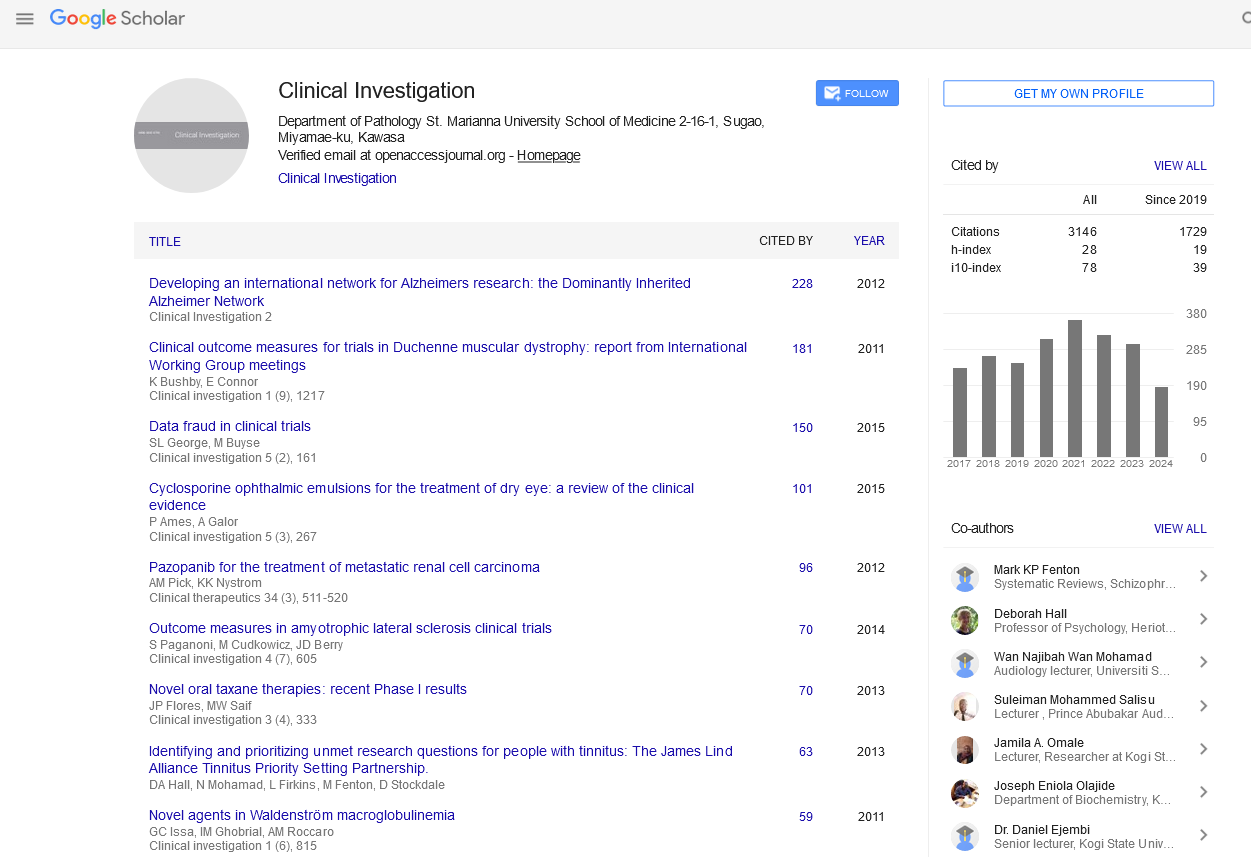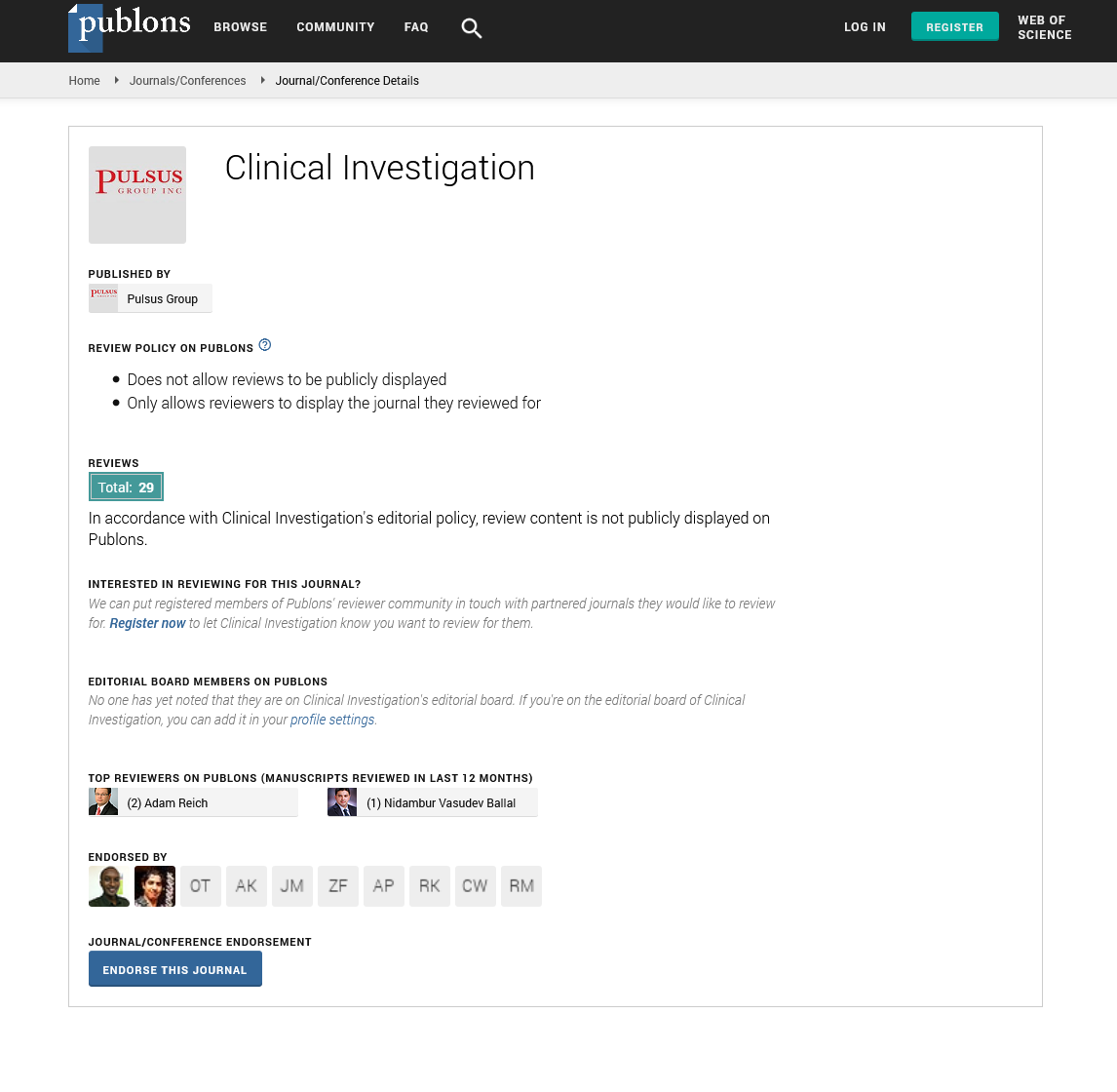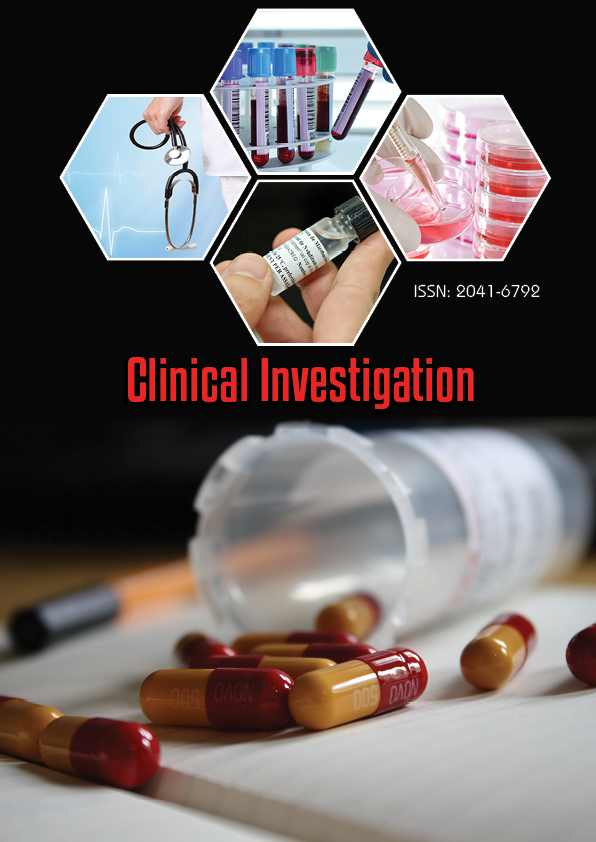Perspective - Clinical Investigation (2024) Volume 14, Issue 4
Angiography: A Critical Tool in Modern Diagnostic and Therapeutic Medicine
- Corresponding Author:
- Nisank Rao
Faculty of Biology, Kurushetra University, India
E-mail: Nisankrao@gmail.com
Received: 6-April-2024, Manuscript No. fmci-25-160369; Editor assigned: 8-April-2024, PreQC No fmci-25-160369(PQ); Reviewed: 13-April-2024, QC No. fmci-25-160369; Revised: 24- April-2024, Manuscript No. fmci-25-160369(R); Published: 28-April-2024
Abstract
Angiography is a diagnostic imaging technique used to visualize the inside of blood vessels and organs, primarily to detect blockages, aneurysms, and other vascular conditions. It is most commonly employed to examine the coronary arteries of the heart, as well as the brain, kidneys, and peripheral arteries. By using a contrast agent and advanced imaging technologies such as X-rays, CT scans, or MRI, angiography provides detailed images that help clinicians diagnose and manage vascular diseases. This article explores the various types of angiography, their procedures, benefits, risks, and the significant role they play in the treatment and management of cardiovascular and other vascular disorders. With advancements in imaging technology, angiography continues to be a cornerstone in modern medicine, enabling early detection and precise intervention for a range of vascular conditions.
Keywords
Angiography • Diagnostic imaging • Blood vessels • Coronary arteries • Vascular dis-eases • Contrast agent • X-ray • CT scan • MRI
Introduction
Angiography is a critical diagnostic procedure that has revolutionized the way vascular conditions are detected and managed. It involves the use of various imaging techniques, such as X-ray, Computed Tomography (CT), or Magnetic Resonance Imaging (MRI), along with a contrast agent that makes blood vessels visible. This allows healthcare providers to assess the condition of blood vessels, detect abnormalities, and plan effective treatment strategies.
The primary goal of angiography is to visualize the vascular system, especially when there is suspicion of blockages, stenosis (narrowing of blood vessels), or other issues such as aneurysms, congenital malformations, or vascular tumors. The most common form of angiography is coronary angiography, used to examine the coronary arteries of the heart. However, angiography can also be used to assess other major arteries and veins in the body, including those in the brain, kidneys, and extremities.
Advancements in imaging technology have greatly improved the accuracy, safety, and versatility of angiography. This article aims to provide an overview of angiography, including its types, procedures, uses, benefits, risks, and its role in diagnosing and treating various vascular conditions.
Types of angiography
• Coronary angiography: Coronary angiography is one of the most widely used types of angiography. It is primarily used to assess the coronary arteries and diagnose Coronary Artery Disease (CAD), which is a leading cause of heart attacks. This procedure involves injecting a contrast dye into the coronary arteries, and using X-rays to capture real-time images of the blood vessels. Coronary angiography helps identify blockages, narrowing, or plaque buildup that could restrict blood flow to the heart muscle. If blockages are found, angiography can also guide decisions about further interventions, such as angioplasty (stenting) or Coronary Artery Bypass Surgery (CABG).
• Cerebral angiography: Cerebral angiography is used to examine the blood vessels in the brain. It helps detect conditions such as brain aneurysms, Arteriovenous Malformations (AVMs), and blockages caused by strokes. A catheter is usually inserted into an artery, often in the groin, and threaded up to the brain’s arteries, where a contrast dye is injected to visualize blood flow in the cerebral vessels. This type of angiography is crucial for understanding the cause of neurological symptoms and planning surgical or endovascular interventions.
• Peripheral angiography: Peripheral angiography is used to visualize blood flow in the arteries of the limbs, particularly when there is a concern for Peripheral Artery Disease (PAD), which can lead to reduced blood supply to the legs and feet. By identifying blockages or narrowing in the arteries, peripheral angiography helps in the assessment of patients with intermittent claudication, gangrene, or non-healing ulcers. This can guide treatments, such as angioplasty, stenting, or surgery.
• Renal angiography: Renal angiography examines the blood vessels in the kidneys. This procedure is useful for diagnosing conditions like renal artery stenosis (narrowing of the renal arteries), which can cause hypertension and kidney dysfunction. By visualizing the renal blood vessels, doctors can identify potential causes of kidney failure or hypertension and determine appropriate treatments.
• Pulmonary angiography: Pulmonary angiography is used to examine the blood vessels in the lungs and is commonly employed in the diagnosis of Pulmonary Embolism (PE). PE occurs when a blood clot obstructs a pulmonary artery, limiting blood flow to the lungs. Pulmonary angiography allows doctors to visualize the extent of the blockage and guide treatment options, such as anticoagulation therapy or surgical removal of the clot.
• Computed Tomography (CT) angiography: CT angiography uses a CT scanner and contrast dye to produce detailed, 3D images of blood vessels. It is less invasive than traditional angiography and provides high-resolution images of arteries and veins, making it useful for detecting a range of vascular conditions, including aneurysms, blockages, and malformations. CT angiography can be performed relatively quickly, making it a valuable diagnostic tool in emergency settings.
• Magnetic Resonance Angiography (MRA): MRA is a non-invasive imaging technique that uses magnetic fields and radio waves to create detailed images of blood vessels. Unlike traditional angiography, MRA does not require the use of X-rays or a contrast dye, although a contrast agent may sometimes be used to enhance visibility. MRA is especially useful in evaluating blood vessels in the brain, neck, and kidneys, and is a preferred method for patients with allergies or sensitivities to contrast dyes.
Benefits of angiography
• Accurate diagnosis: Angiography provides detailed, real-time images that help doctors accurately diagnose various vascular conditions, including blockages, aneurysms, and malformations. This precision enables more targeted treatment planning.
• Minimally invasive: Compared to traditional surgery, angiography is minimally invasive, typically requiring only a small incision. This reduces the risk of infection, minimizes recovery time, and allows for quicker discharge from the hospital.
• Guiding interventions: Angiography not only aids in diagnosis but also plays a key role in guiding interventional procedures, such as angioplasty, stent placement, and embolization (blocking abnormal vessels). This makes it a critical tool in treating vascular diseases.
• Monitoring disease progression: For chronic vascular conditions, such as coronary artery disease or peripheral artery disease, angiography can be used periodically to monitor disease progression and the effectiveness of treatments.
Risks of angiography
• Allergic reaction to contrast dye: Some patients may experience an allergic reaction to the contrast dye used in angiography. While most reactions are mild (such as itching or rash), severe reactions, such as anaphylaxis, are rare but can occur.
• Bleeding or infection: As a minimally invasive procedure, angiography still carries a risk of bleeding or infection at the catheter insertion site. These risks are typically low but can be more significant in patients with underlying conditions, such as diabetes or anticoagulant therapy.
• Kidney damage: The contrast dye used in angiography can occasionally cause kidney damage, particularly in patients with pre-existing kidney conditions. Proper precautions and monitoring are essential to minimize this risk.
• Radiation exposure: Some forms of angiography, such as X-ray angiography, involve exposure to ionizing radiation. Although the doses are generally low, repeated exposure may increase the risk of long-term effects.
Conclusion
Angiography remains one of the most important diagnostic tools in modern medicine, offering invaluable insights into the structure and function of blood vessels. Its applications span across numerous specialties, including cardiology, neurology, nephrology, and oncology, allowing for the early detection of vascular conditions and enabling targeted interventions. With the advent of advanced imaging technologies, angiography continues to evolve, becoming safer, more effective, and less invasive. As a result, it plays a critical role in improving patient outcomes by guiding clinicians in diagnosing, monitoring, and treating various vascular diseases.
Despite its many benefits, angiography is not without risks, and careful patient selection and proper technique are essential to minimize complications. Nonetheless, with its ability to provide real-time, high-resolution images, angiography remains a cornerstone of modern diagnostic and therapeutic medicine, ensuring better clinical decision-making and improved patient care.


